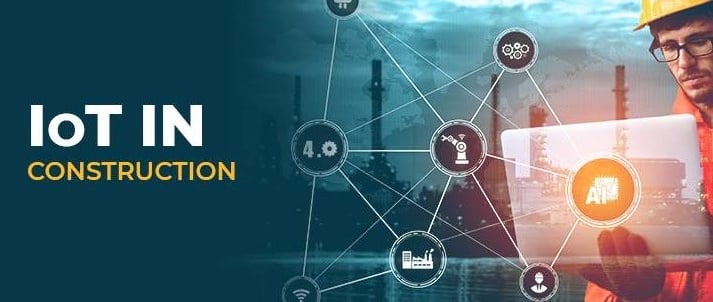The Impact of IoT on Project Success in the Construction Sector
Explore how the Internet of Things (IoT) is revolutionizing the construction sector in our latest blog. Understand the profound impact IoT has on project success by enhancing real-time monitoring, improving safety, optimizing resource management, and driving efficiency. Learn about practical IoT applications, implementation strategies, and real-world case studies that showcase significant improvements in project outcomes.
BLOG
10/10/20244 min read


Introduction
The Internet of Things (IoT) has revolutionized numerous industries by enabling connectivity and data exchange between devices. In the construction sector, IoT is particularly transformative, offering new ways to enhance project success through improved efficiency, safety, and collaboration. For small to medium-sized businesses (SMBs) in the construction industry, leveraging IoT can provide a competitive edge, enabling them to deliver projects on time, within budget, and with enhanced quality. This blog explores the various impacts of IoT on construction projects and provides actionable insights for SMBs looking to integrate IoT into their operations.
1. Understanding IoT in Construction
IoT refers to the network of physical objects embedded with sensors, software, and other technologies to connect and exchange data with other devices and systems over the internet. In construction, IoT devices can range from simple sensors that monitor environmental conditions to complex systems that track equipment usage and worker movements.
Key Components of IoT in Construction:
Sensors and Actuators: Devices that monitor conditions such as temperature, humidity, and vibrations.
Wearables: Smart helmets and vests that track worker health and safety.
Smart Equipment: Machinery equipped with IoT devices for monitoring usage and performance.
Drones: Used for site surveys, progress monitoring, and safety inspections.
Building Information Modeling (BIM): Integrated with IoT for real-time data on building conditions and progress.
2. Enhancing Efficiency with IoT
One of the primary benefits of IoT in construction is the enhancement of operational efficiency. IoT devices provide real-time data that can be used to optimize various aspects of the construction process.
Real-Time Monitoring and Data Analytics:
Equipment Utilization: IoT sensors on machinery can track usage patterns, identify underutilized equipment, and schedule maintenance proactively, reducing downtime and extending the lifespan of assets.
Inventory Management: Smart tags and sensors can provide real-time updates on inventory levels, ensuring that materials are available when needed and reducing delays due to stockouts.
Optimizing Resource Allocation:
Worker Productivity: Wearable devices can monitor worker locations and activities, providing insights into productivity and helping managers allocate resources more effectively.
Energy Management: IoT-enabled energy management systems can monitor and control energy usage on construction sites, reducing costs and environmental impact.
3. Improving Safety and Compliance
Safety is a critical concern in the construction industry, and IoT plays a significant role in enhancing workplace safety and ensuring compliance with regulations.
Real-Time Safety Monitoring:
Wearables for Workers: Smart helmets and vests can monitor vital signs and environmental conditions, alerting workers and supervisors to potential hazards such as heat stress or toxic gas exposure.
Geofencing and Proximity Alerts: IoT devices can create virtual boundaries and send alerts if workers enter hazardous areas or come too close to dangerous equipment.
Incident Response and Reporting:
Immediate Alerts: IoT systems can provide immediate alerts in case of accidents, enabling faster response times and potentially reducing the severity of injuries.
Automated Reporting: Data from IoT devices can be used to generate detailed incident reports, helping businesses comply with safety regulations and improve their safety protocols.
4. Enhancing Collaboration and Communication
Effective communication and collaboration are essential for project success, and IoT can facilitate better interaction between project stakeholders.
Connected Job Sites:
Unified Communication Platforms: IoT integrates with communication platforms, enabling seamless information sharing between on-site workers and off-site managers.
Data Sharing: Real-time data from IoT devices can be shared across teams, ensuring everyone has access to the latest information and can make informed decisions.
Collaboration Tools:
BIM Integration: IoT data can be integrated into BIM, providing a comprehensive view of the project and enabling better coordination between different teams.
Mobile Apps: Mobile applications connected to IoT devices allow workers to access project data, report issues, and communicate with team members from anywhere on the site.
5. Reducing Costs and Increasing Profitability
For SMBs in the construction sector, managing costs and maximizing profitability are crucial. IoT offers several ways to reduce expenses and increase efficiency.
Predictive Maintenance:
Reducing Downtime: IoT sensors can predict when equipment is likely to fail, allowing for maintenance to be scheduled before breakdowns occur, thus reducing costly downtime.
Optimizing Maintenance Schedules: Data from IoT devices can be used to optimize maintenance schedules, ensuring that machinery is serviced at the right intervals to maximize its lifespan.
Cost Management:
Energy Savings: IoT-enabled energy management systems can reduce energy consumption on construction sites, leading to significant cost savings.
Material Management: Real-time inventory tracking helps prevent over-ordering and material wastage, reducing costs associated with excess materials.
6. Implementing IoT in Your Construction Business
For SMBs looking to adopt IoT in their construction projects, the following steps can serve as a guide:
Assessment and Planning:
Identify Needs: Assess the specific needs and challenges of your construction projects that IoT can address.
Develop a Plan: Create a detailed plan outlining the IoT devices and systems you will implement, the expected benefits, and the resources required.
Selecting the Right IoT Solutions:
Research and Compare: Research different IoT solutions available in the market and compare their features, costs, and compatibility with your existing systems.
Pilot Testing: Conduct pilot tests to evaluate the effectiveness of IoT solutions before full-scale implementation.
Integration and Training:
System Integration: Ensure that IoT devices are integrated with your existing project management and communication systems for seamless data exchange.
Training and Support: Provide training to your workforce on how to use IoT devices and systems, and establish a support system to address any issues that arise.
Monitoring and Optimization:
Continuous Monitoring: Regularly monitor the performance of IoT devices and systems to ensure they are delivering the expected benefits.
Continuous Improvement: Use data from IoT devices to identify areas for improvement and optimize your processes accordingly.
Conclusion
The integration of IoT into construction projects offers significant benefits for SMBs, including enhanced efficiency, improved safety, better collaboration, and reduced costs. By adopting IoT technologies, construction businesses can not only improve their project success rates but also gain a competitive edge in the market. As IoT continues to evolve, its potential to transform the construction industry will only grow, making it an essential consideration for forward-thinking construction companies.
For SMBs ready to embrace IoT, the key to success lies in careful planning, selecting the right solutions, and continuously optimizing their use of IoT technologies. By doing so, they can ensure that their projects are completed on time, within budget, and to the highest standards of quality and safety.
References:
© 2025. All rights reserved.

